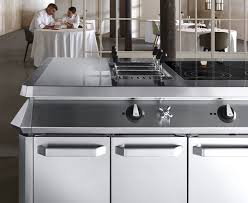The restaurant and foodservice industry continues to evolve rapidly, driven by advances in technology, sustainability, and changing consumer expectations. As we move into 2025, commercial kitchen equipment is at the forefront of this transformation. From smart appliances and energy-efficient designs to multifunctional and space-saving innovations, the latest trends are helping restaurants improve efficiency, reduce costs, and deliver exceptional food quality.
Smart Technology Integration
One of the biggest trends in commercial kitchen equipment for 2025 is the continued rise of smart technology. Connected appliances can now communicate with one another, providing real-time performance data that allows kitchen managers to monitor energy usage, track maintenance needs, and remotely adjust temperatures.
Internet of Things (IoT) technology is enabling predictive maintenance, which helps prevent costly equipment failures before they happen. Smart fryers, ovens, and refrigeration units can send alerts when components need service or when temperature fluctuations occur. This technology not only minimizes downtime but also ensures food safety and consistency, two of the most critical factors in commercial kitchens.
Sustainability and Energy Efficiency
Sustainability remains a top priority across the foodservice industry, and 2025 brings even greater emphasis on eco-friendly commercial kitchen equipment. Manufacturers are developing appliances that consume less water and energy while still delivering high performance. Induction cooking, for example, continues to gain popularity because it transfers heat directly to cookware, reducing energy waste and improving safety.
Many brands are also using recyclable materials and natural refrigerants to minimize environmental impact. Energy Star-certified equipment has become the industry standard, offering restaurants long-term savings on utility costs and helping them meet sustainability goals. With rising energy prices and stricter environmental regulations, energy-efficient solutions are no longer optional; they’re essential.
Compact and Modular Designs
As urbanization increases and restaurant spaces become smaller, compact and modular commercial kitchen equipment is in high demand. Equipment manufacturers are designing multifunctional units that perform multiple tasks in one footprint, such as combination ovens that can bake, steam, and roast.
Modular kitchen setups also provide flexibility for growing businesses. Restaurants can reconfigure their layout or add new equipment as their menu or capacity expands. This trend is particularly beneficial for ghost kitchens and quick-service restaurants, where space optimization is vital for efficiency and profitability.
Automation and Labor Efficiency
Labor shortages continue to challenge the foodservice industry, and automation has become a key solution. In 2025, automated commercial kitchen equipment is streamlining repetitive tasks like frying, mixing, or cleaning. Smart cooking systems can follow preprogrammed recipes, reducing the need for constant supervision and ensuring consistent results across shifts.
Robotics is also making its way into commercial kitchens. Automated fryers, robotic arms for plating, and self-cleaning ovens are improving speed, precision, and safety. These innovations allow kitchen staff to focus on more skilled tasks, enhancing overall productivity and employee satisfaction.
Enhanced Food Safety and Hygiene
Post-pandemic, food safety and sanitation continue to be major concerns for the restaurant industry. New commercial kitchen equipment models are being designed with hygiene in mind, featuring smooth, easy-to-clean surfaces and fewer mechanical parts that can trap bacteria. Touchless technology is becoming more common in dispensers, sinks, and even cooking appliances, reducing cross-contamination risks.
Advanced monitoring systems can now track water filtration, temperature control, and air quality, ensuring that kitchens maintain compliance with food safety standards. These innovations help restaurants maintain consumer trust while reducing manual oversight.
Data-Driven Performance and Analytics
The future of commercial kitchen equipment lies in data-driven decision-making. Cloud-based management platforms are helping operators analyze performance metrics such as energy consumption, cooking times, and maintenance schedules. This data helps restaurant owners make informed decisions about equipment usage, replacement, and overall efficiency.
By using analytics to fine-tune operations, restaurants can identify inefficiencies and optimize workflows, leading to faster service, lower costs, and improved profitability.
The commercial kitchen equipment landscape in 2025 is defined by innovation, sustainability, and smart technology. As the industry adapts to changing demands, restaurant owners and operators are embracing solutions that enhance efficiency, reduce environmental impact, and maintain food quality. From connected appliances and energy-efficient designs to modular layouts and automation, the next generation of commercial kitchen equipment is shaping a more efficient, sustainable, and data-driven future for foodservice operations.

